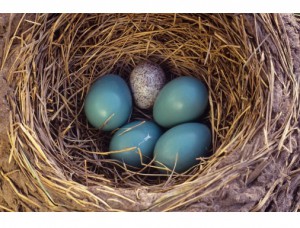For many avian species, raising young is a very large investment. Instead of doing it themselves, some birds use a method called brood parasitism, leaving an egg or multiple eggs in a host bird’s nest to be raised there. This can be a severe problem for the host, as there is often potential for their own young to not get enough nourishment and sometimes even die or be killed by the parasitic chicks. Many defenses have been evolved to combat this, including rejection of foreign eggs. Since parasite eggs can often evolve to resemble host eggs, the host species might evolve strategies to more accurately discriminate between their own eggs and parasitic ones.

Mottled cowbird egg among host robin eggs.
http://www.pbs.org/wgbh/nova/sciencenow/0407/03-moth-01.html
This study tested three different hypothesis. The first two were previously proposed hypotheses: There should be minimal variation within a single clutch and there should be high variation between the eggs of females within species. The authors also proposed and tested a new hypothesis that there would be more variation among eggs of host species than of species that are not subject to brood parasitism. To test these hypothesis, they examined the eggs of 40 different Australian species and analyzed pattern and color differences among these species.
There was no significant difference found in color between host and non-host species. They did, however, find larger differences in egg pattern in hosts. Among host species that shared the same parasite there were smaller pattern differences. The eggs of host species had significantly more variation in egg pattern than those of non-host species. While two of the hypotheses were supported by the results, the first hypothesis, that there would be minimal variation within a clutch, was not. Instead, the authors found higher within-clutch variation in host species.
This experiment shows, quite possibly for the first time, that pairs of host species have diverged more in egg pattern than pairs of non-host species. It also demonstrates that divergence in characteristics is smaller than hosts that share a parasite. This result was expected as many species that share a parasite are often closely related and would therefore potentially have more similar eggs. The results of this study provide substantial evidence that brood parasitism is a driving force in the evolution of egg diversity. One very large challenge of evolutionary biology is explaining and understanding observed diversity patterns, and these results have now contributed to our understanding of diversity among quite a few species.
Reference:
Medina, I., Troscianko, J., Stevens, M., Langmore, N.E. (2016). Brood parasitism is linked to egg pattern diversity within and among species of Australian passerines. The American Naturalist, 187, 351-362.
